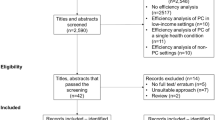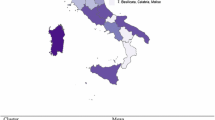Abstract
The aim of this paper is to extend the existing literature about efficiency measurement in primary health care with the application of a recently developed method to deal with exogenous variables. In this context, these variables are represented by the main characteristics of the covered population. The use of this technique allows calculating more accurate efficiency scores that can reflect the performance of units more properly. Our results show that the inclusion of these variables in the evaluation has a great impact on both the values of efficiency scores and the rank of units. This analysis has been carried out using a great amount of data available about primary health care centers in the Spainsh region of Extremadura.
Similar content being viewed by others
Notes
The reader is referred to [4] and [5] for a comprehensive review on the measurement of economic efficiency of hospitals. For a survey of applications on primary care services, see [6] and [7]. A theoretical overview of main frontier techniques for the measurement of economic efficiency can be found in [8].
DEA is considered preferable to any other approaches when the aim of the study is to measure the efficiency of a group of units producing several outputs [33].
See [43] for an illustrated explanation of slacks.
See [52] for a detailed review on different methodological options available to incorporate the effect of exogenous variables into efficiency analysis through non-parametric techniques,
See [53] for details.
See Muñiz [13], p. 631 for a detailed explanation of alternative correction mechanisms.
We also considered the inclusion of a proxy variable for the capital structure of the care centre area measured in squared feet, but we finally refused to use it on the basis of statistical criteria (the value of the correlation coefficient between this variable and output variables is always lower than 0.2) and according to results obtained in previous studies [49]. In addition, it is worth mentioning that, on average, capital accounted for only 6% of overall costs in our sample.
For instance, the Pearson correlation coefficients (in absolute values) between these variables and FREQUENCYGP are: GNR (0.544), DR (0.659), LR (0.710), MR (0.545), RR (0.604), DENSITY (0.508), AGRIEMP (0.447) and SERVIEMP (0.546). Data on other output variables are available upon request.
The use of this model when input variables are in the form of ratios can result incorrect efficiency scores according to the demonstration provided in [57]. However, the modified DEA model proposed in that paper to avoid this problem cannot be used in our analysis since it requires knowing the values of the nominator and denominator of the ratio and our database does not provide that information.
Some of the exogenous variables are positively correlated with total slacks, i.e., negatively correlated with efficiency scores (DR, LR and AGRIEMP). Thus, they have been transformed by using their inverse values for a correct application of the three-stage model.
References
Nunamaker, T. R., Measuring routine nursing service efficiency: A comparison of cost per patient day and data envelopment analysis models. Health Serv. Res. 18:183–205, 1983.
Hollingsworth, B., and Street, A., The market for efficiency analysis of health care organizations. Health Econ. 15:1055–1059, 2006.
Worthington, A. C., Frontier efficiency measurement in health care: a review of empirical techniques and selected applications. Med. Care Res. Rev. 61 (2)135–170, 2004.
Chilingerian, J. A., and Sherman, H., Health care applications: From hospitals to physicians, from productive efficiency to quality Frontiers. In: Cooper, W. W., Seiford, L. M., and Zhu, J. (Eds.), Handbook on Data Envelopment AnalysisKluwer, London, pp. 481–537, 2004.
Seinmann, L., Dittrich, G., Karmann, A., and Zweifel, P., Measuring and comparing the (in)efficiency of German and Swiss hospitals. Eur. J. Health Econ. 5:216–226, 2004.
Puig-Junoy, J., Eficiencia en la Atención Primaria de Salud: Una revisión crítica de las medidas frontera. Rev. Esp. Salud Púb. 74:483–495, 2000.
Amado, C. A., and Dyson, R. G., On comparing the performance of primary care providers. Eur. J. Oper. Res. 185:915–932, 2008.
Murillo-Zamorano, L. R., Economic efficiency and frontier techniques. J. Econ. Surv. 18 (1)33–77, 2004.
Chilingerian, J. A., Evaluating physician efficiency in hospitals: a multivariate analysis of best practice. Eur. J. Oper. Res. 80:548–574, 1995.
Rosko, M. D., Impact of internal and external environmental pressures on hospital inefficiency. Health Care Manag. Sci. 2:63–74, 1999.
Kontodimopoulos, N., Moschovakis, G., Aletras, V., and Niakas, D., The effect of environmental factors on technical and scale efficiency of primary health care providers in Greece. Cost Eff. Resour. Alloc. 5:14, 2007. doi:10.1186/1478-7547-5-14.
Fried, H. O., and Lovell, C. A. K., Searching for the Zeds, paper presented in the second Georgia Productivity Workshop, 1996.
Muñiz, M., Separating managerial inefficiency and external conditions in data. Eur. J. Oper. Res. 149-3:625–643, 2002.
Huang, Y.-G. L., and McLaughlin, C. P., Relative efficiency in rural primary health care: An application of data envelopment analysis. Health Serv. Res. 24 (2)143–158, 1989.
Szczepura, A., Davies, A., Fletcher, C., and Boussofiane, A., Efficiency and effectiveness in general practice. J. Manag. Med. 7 (5)36–47, 1993.
Bates, J., Baines, D., and Whynes, D., Measuring the efficiency of prescribing by general practitioners. J. Oper. Res. Soc. 47:1443–1451, 1996.
Giuffrida, A., Productivity, efficiency changes in primary care: a Malmquist index approach. Health Care Manage. Sci. 2:11–26, 1999.
Hollingsworth, B., Dawson, P. J., and Maniadakis, N., Efficiency measurement of health care: A review of non-parametric methods and applications. Health Care Manage. Sci. 2:161–172, 1999.
Pina, V., and Torres, L., Evaluating the efficiency of non-profit organizations: An application of data envelopment analysis to the public health services. Financ. Account. Manag. 8:213–225, 1992.
Chilingerian, J., and Sherman, H., Benchmarking physician practice patterns with DEA: A multi-stage approach for cost containment. Ann. Oper. Res. 67:83–116, 1996.
Chilingerian, J., and Sherman, H., DEA and primary care physicians report cards: Deriving preferred practice cones from managed care service concepts and operating strategies. Ann. Oper. Res. 73:35–66, 1997.
Ozcan, Y. A., Physician benchmarking: Measuring variation in practice behavior in treatment of otitis media. Health Care Manage. Sci. 1:5–17, 1998.
Goñi, S., An analysis of the effectiveness of the Spanish primary health care teams. Health Policy. 48:107–117, 1999.
Salinas-Jiménez, J., and Smith, P. C., Data envelopment analysis applied to quality in primary health care. Ann. Oper. Res. 67:141–161, 1996.
García, F., Marcuello, C., Serrano, D., and Urbina, O., Evaluation of efficiency in primary healt care centres: an application of data envelopment analysis. Financ. Account. Manag. 15 (1)67–83, 1999.
Rosenman, R., and Friesner, D., Scope and scale efficiencies in physician practices. Health Econ. 13:1091–1116, 2004.
Puig-Junoy, J., and Ortún, V., Cost efficiency in primary care contracting: a stochastic frontier cost function approach. Health Econ. 13:1149–1165, 2004.
Schmacker, E. R., and McKay, N. L., Factors affecting productive efficiency in primary care clinics. Health Serv. Manage. Res. 21:60–70, 2008.
Murillo, L. R., and Petraglia, C., Technical efficiency in primary health care: does quality matter?”, Working paper #10725, MPRA, University Library of Munich, 2008.
Morita, H., Analysis of economies of scope by data envelopment analysis: Comparison of efficient frontiers. Int. Trans. Oper. Res. 10:393–402, 2003.
Charnes, A., Cooper, W. W., and Rhodes, E., Measuring the efficiency of decision making units. Eur. J. Oper. Res. 2 (6)429–444, 1978.
Banker, R. D., Charnes, A., and Cooper, W. W., Some models for estimating technical and scale inefficiencies in data envelopment analysis. Management Science. 30 (9)1078–1092, 1984.
Seiford, L. M., and Thrall, R. M., Recent Developments in DEA: the mathematical programming approach to Frontier analysis. J. Econom. 46 (1/2)7–38, 1990.
Charnes, A., Cooper, W. W., Lewin, A. Y., and Seiford, L. M., Data envelopment analysis: theory, methodology and applications. Kluwer, New York, 1994.
Cooper, W. W., Seiford, L. M. and Tone, K., Data envelopment analysis: a comprehensive text with models, applications, references and DEA-solver software. Kluwer: New York.
Thanassoulis, E., Introduction to the theory and application of data envelopment analysis. Kluwer, Dordrecht, 2001.
Emrouznejad, A., Parker, B. R., and Tavares, G., Evaluation of research on efficiency and productivity: a survey and analysis of the first 30 years of scholarly literature in DEA. Socio-Econ. Plann. Sci. 42 (3)151–157, 2008.
Hoff, A., Second stage DEA: Comparison of approaches for modelling the DEA score. Eur. J. Oper. Res. 181:425–435, 2007.
Banker, R., and Natarajan, R., Evaluating contextual variables affecting productivity using data envelopment analysis. Oper. Res. 56 (1)48–58, 2008.
McDonald, J., Using least squares and tobit in second stage DEA analyses. Eur. J. Oper. Res. 197:792–798, 2009.
Banker, R. D., and Morey, R. C., Efficiency analysis for exogenously fixed inputs and outputs. Oper. Res. 34 (4)513–521, 2008.
Golany, B., and Roll, Y., Some extensions of techniques to handle non-discretionary factors in data envelopment analysis. J. Prod. Anal. 4:419–432, 1993.
Tofallis, C., Combining two approaches to efficiency assessment. J. Oper. Res. Soc. 52:1225–1231, 2001.
Ray, S. C., Resource use efficiency in public schools: A study of Connecticut data. Manag. Sci. 37 (12)1620–1628, 1991.
Afonso, A., and St. Aubyn, M., Cross-country efficiency of secondary education provision: a semi-parametric analysis with non-discretionary inputs. Econ. Model. 23(3):476–491, 2006.
Prado, J. M., and García-Sánchez, I., Efficiency evaluation in municipal services. an application to the street lighting service in Spain. J. Prod. Anal. 27:149–162, 2007.
Ruggiero, J., Non-discretionary inputs in data envelopment analysis. Eur. J. Oper. Res. 111:461–469, 1998.
Fried, H., Schmidt, S., and Yaisawarng, S., Incorporating the operating environment into a nonparametric measure of technical efficiency. J. Prod. Anal. 12:249–267, 1999.
Fried, H., Lovell, C. A. K., Schmidt, S., and Yaisawarng, S., Accounting for environmental effects and statistical noise in data envelopment analysis. J. Prod. Anal. 17:157–174, 2002.
Muñiz, M., Paradi, J., Ruggiero, J., and Yang, Z., Evaluating alternative DEA models used to control for non-discretionary inputs. Comput. Oper. Res. 33:1173–1183, 2006.
Cordero, J. M., Pedraja, F., and Santin, D., Alternative approaches to include exogenous variables in DEA measures: A comparison using Monte Carlo. Comput. Oper. Res. 36:2699–2706, 2009.
Cordero, J. M., Pedraja, F., and Salinas, J., Measuring efficiency in education: An analysis of different approaches for incorporating non-discretionary inputs. Appl. Econ. 40 (10)1323–1339, 2008.
Simar, L., and Wilson, P., Estimation and inference in two-stage, semi parametric models of production processes. J. Econ. 136:31–64, 2007.
Vega-Cervera, J. A., Murillo-Zamorano, L. R., DeMiguel, F., Morillo, J., and Rivero, M., Un sistema integrado de información para la atención primaria en Extremadura. Consejería de Sanidad y Consumo, Junta de Extremadura, 2007.
Hollingsworth, B., and Smith, P., Use of ratios in data envelopment analysis. Appl. Econ. Lett. 10:733–735, 2003.
Torgersen, A. M., Forsund, F. R., and Kittelsen, S. A. C., Slack-adjusted efficiency measures and ranking of efficient unit. J. Prod. Anal. 7 (4)379–398, 1996.
Emrouznejad, A., and Amin, G. R., DEA models for ratio data: Convexity consideration. Appl. Math. Model. 33 (1)486–498, 2009.
Coelli, T., A guide to DEAP Version 2.1: A data envelopment analysis (computer) program”, CEPA Working Paper 96/08, Australia: University of New England, 1996.
Coelli, T., A Multi-stage methodology for the solution of orientated DEA Models. Oper. Res. Lett. 23:143–149, 1998.
Acknowledgments
The authors are most grateful to the Consejeria de Sanidad y Dependencia of the Junta de Extremadura for its financial and data availability support. We also thank Carmelo Petraglia for his helpful assistance in preparing the data set used in the research and to three anonymous referes por for their comments and suggestions.
Author information
Authors and Affiliations
Corresponding author
Additional information
An erratum to this article can be found at http://dx.doi.org/10.1007/s10916-011-9782-2
Appendix
Appendix
Rights and permissions
About this article
Cite this article
Cordero-Ferrera, J.M., Crespo-Cebada, E. & Murillo-Zamorano, L.R. Measuring Technical Efficiency in Primary Health Care: The Effect of Exogenous Variables on Results. J Med Syst 35, 545–554 (2011). https://doi.org/10.1007/s10916-009-9390-6
Received:
Accepted:
Published:
Issue Date:
DOI: https://doi.org/10.1007/s10916-009-9390-6




